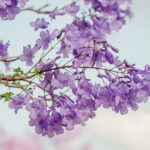Indigo plants hold a captivating allure, rich with a tapestry of vibrant history and modern uses. Prepare to embark on a journey of discovery as we unveil the mystique surrounding these enchanting botanical wonders. This article delves into the depths of indigo plants, unraveling their cultural significance, intricate properties, and the remarkable ways in which they continue to shape our world. So, fasten your seatbelts as we explore the vivid world of indigo plants, ready to be mesmerized by their secrets.

Indigo Plants
Indigo plants, with their vibrant history and modern uses, have captivated curious minds for centuries. These fascinating plants belong to the Indigofera genus, which boasts an impressive variety of over 750 species. From the Eastern Coneflower to the Wild Indigo, each species offers its own unique charm and characteristics.
The name “indigo” stems from the deep blue dye extracted from Indigofera tinctoria, which has been used for thousands of years. This dye holds a profound cultural significance, as it has been utilized in various civilizations throughout history to create beautiful textiles and artwork.
But indigo plants aren’t just admired for their aesthetics and dye-producing qualities. Some species also possess remarkable medicinal properties, while others are grown for their ornamental value. It’s truly remarkable how versatile these plants can be!
Cultivating Indigo Plants
If you’re interested in growing your own indigo plants, you’ll be pleased to know that they are quite low-maintenance. With the right conditions, they can flourish in USDA zones 10 and 11. Here are a few key tips and steps to get you started:
Choose the appropriate species: Different species of indigo plants have varying growth habits and requirements. Select a species that suits your climate and preferences.
Provide well-draining soil: Indigo plants thrive in soil that is well-draining. Make sure to amend the soil with organic matter if necessary.
Plant in full sun: Indigo plants love sunbathing! Ensure that they receive ample sunlight for healthy growth and vibrant blooms.
Water moderately: While indigo plants can tolerate dry conditions, they appreciate regular watering. Strike a balance to prevent waterlogged soil.
Prune when necessary: Keep an eye out for any dead or diseased branches and promptly remove them. Pruning will help maintain the plant’s shape and overall health.
With these simple steps, you’ll be well on your way to cultivating your very own indigo plants.
The Marvels of Indigo Plants
The magic of indigo plants goes beyond their ornamental and dyeing properties. Did you know that certain Lepidoptera species rely on these plants as their food source? It’s a beautiful example of nature’s intricate interconnectedness. The larvae of these butterflies and moths feed on the foliage, creating a symbiotic relationship with the indigo plants.
But it doesn’t stop there. Indigo plants have also made their way into various modern industries. Their blue dye is still widely used today, finding its applications in fashion, cosmetics, and even food coloring. These plants continue to weave themselves into the fabric of our everyday lives.
As we delve further into the realm of indigo plants, we encounter a vast array of colors, scents, and textures. Each species holds its own secrets and stories, waiting to be discovered. It’s a botanical adventure worth embarking on.
In conclusion, indigo plants have a rich history, cultural significance, and an enduring place in our modern world. They are fascinating in every sense, from their mesmerizing dye to their medicinal uses and ornamental value. Delve into the world of indigo plants, uncover their mysteries, and embrace the wonders they have to offer.
“Indigo plants, with their vibrant array of species and diverse uses, present a world of colors waiting to be explored.”
Indigo, a rich and vibrant dye, has fascinated people for centuries. The question often arises: where does indigo grow? The answer is diverse and fascinating. From the deep blue fields of India, where indigo has been cultivated for thousands of years, to the lush gardens of South America and the vast plantations of Africa, indigo can be found thriving in various parts of the world. So, if you’re curious to delve into the origins of this enchanting dye, click here to explore the captivating world of indigo and discover more about where it grows: Where Does Indigo Grow.
FAQ
Question 1
What are indigo plants?
Answer 1
Indigo plants are a diverse group of plants belonging to the Indigofera genus, which consists of over 750 species. Some popular species include Eastern Coneflower, Purple Morning Glory, Common Periwinkle, Purple Verbena, Wild Indigo, Sea Holly, African Lily, and Love-In-A-Mist. These plants are native to North America and can be found growing wild throughout the country. They are known for their natural blue colors, obtained from the leaves and used as a dye.
Question 2
What is the cultural significance of indigo plants?
Answer 2
Indigo plants have a rich history and cultural significance. The name “indigo” comes from the deep blue dye produced by Indigofera tinctoria, which has been used for thousands of years. This dye has played an important role in various cultures, especially in textile production. Indigo has been used to dye fabrics, create traditional garments, and is often associated with spiritual practices and rituals.
Question 3
Can indigo plants be used for medicinal purposes?
Answer 3
Yes, some species of indigo plants have medicinal uses. The Indigofera genus exhibits diverse characteristics and variations among its species, and some of them have been traditionally used in folk medicine. For example, certain species are believed to have anti-inflammatory, diuretic, and antimicrobial properties. However, it is important to consult with a healthcare professional before using any plant for medicinal purposes.
Question 4
How are indigo plants cultivated?
Answer 4
Cultivating indigo plants is relatively simple, and they can thrive in USDA zones 10 and 11. They prefer well-drained soil and full sun exposure. Indigo plants can be grown from seeds or cuttings, and they require regular watering, especially during dry periods. Pruning can help maintain their shape and promote healthier growth. It is important to consider the specific requirements of each species when cultivating indigo plants.
Question 5
Are indigo plants beneficial to wildlife?
Answer 5
Yes, indigo plants serve as food plants for the larvae of certain Lepidoptera species, such as butterflies and moths. Butterflies, in particular, are attracted to the nectar of indigo flowers, contributing to pollination. By cultivating indigo plants, you can create a habitat that supports biodiversity and provides food sources for these beneficial insects.
- China II Review: Delicious Food & Speedy Service - April 17, 2025
- Understand Virginia’s Flag: History & Debate - April 17, 2025
- Explore Long Island’s Map: Unique Regions & Insights - April 17, 2025
















